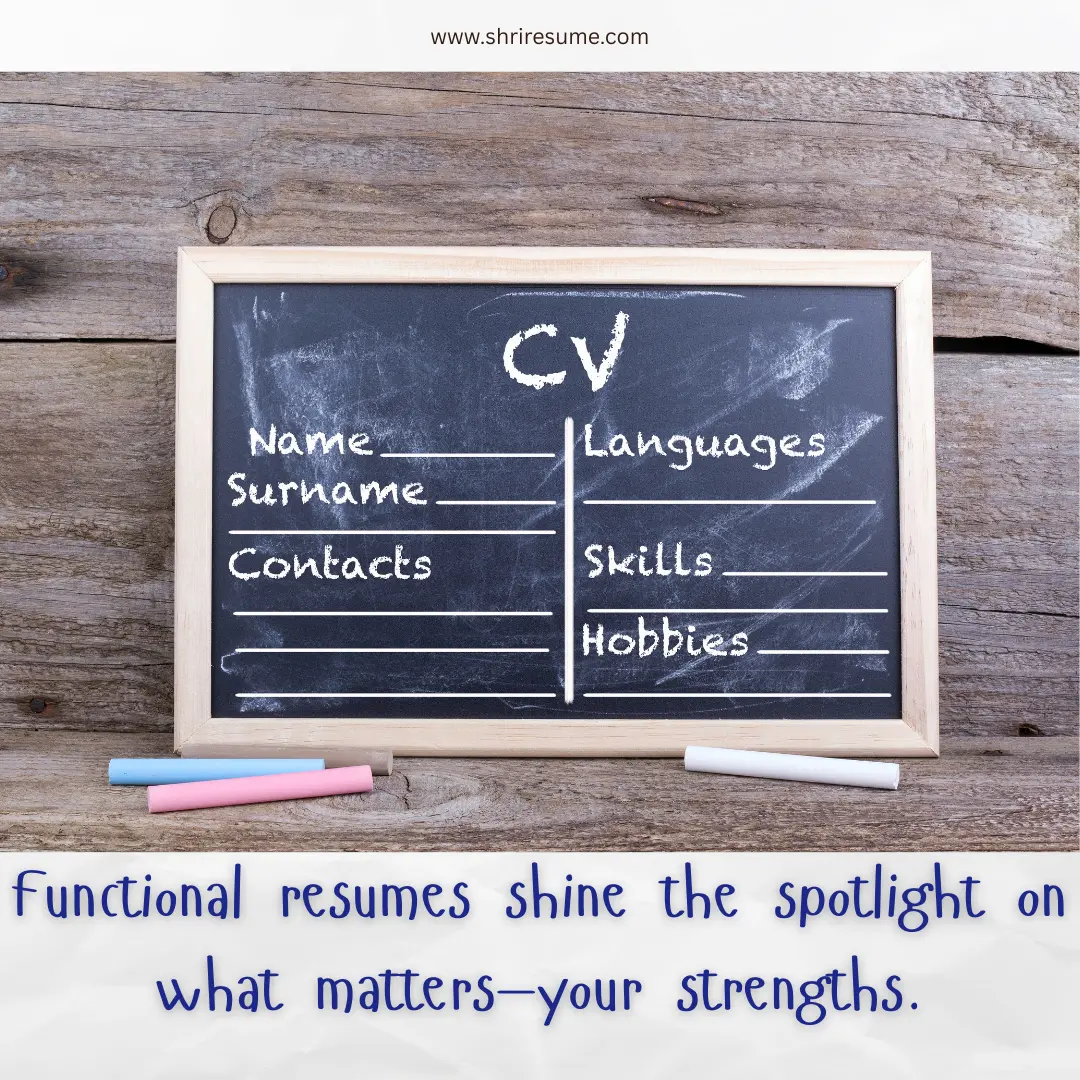Crafting a Functional Resume: A Complete Guide with Templates and Examples for Job Seekers
A functional resume is an alternative to the traditional chronological resume format and is ideal for individuals with non-linear career paths, employment gaps, or those entering the workforce for the first time. Unlike the chronological format which emphasizes your work history, a functional resume focuses on your skills and experience. This format allows you to present your abilities and achievements that are relevant to the job you're applying for—highlighting how your background aligns with the role's requirements.
Crafting a functional resume involves identifying the competencies that best showcase your qualifications for the position. It's essential for those who have acquired skills through various and possibly unrelated jobs, volunteer work, or educational pursuits. A well-written functional resume not only illuminates pertinent skills but also de-emphasizes less relevant work history, which can be beneficial for applicants with diverse or unconventional work experiences.
Key Takeaways
- A functional resume emphasizes skills and accomplishments rather than work history.
- It is particularly useful for those with non-traditional career paths or significant gaps in employment.
- The goal is to align one's unique abilities with the targeted job's requirements, showcasing how they make the candidate suitable for the position.
Understanding Functional Resumes
A functional resume emphasizes an individual's skills and abilities over a chronological work history. This format is particularly beneficial for those with non-traditional work experience or notable gaps in their employment history.
The functional resume structure typically consists of:
- Professional Summary: A brief introduction that highlights the candidate's key strengths and relevant competencies.
- Key Skills: A comprehensive list of skills that are grouped into categories such as "Communication" or "Project Management".
- Accomplishments: Specific achievements that clearly demonstrate how the candidate applied their skills in previous roles or projects.
- Work History: Unlike a chronological resume, the work history section in a functional resume is simplified, listing only job titles, employers, and durations of employment without detailed descriptions.
- Education: The academic background of the individual.
When composing a functional resume, they should focus on transferable skills and experiences that align with the job they are applying for. This approach helps to showcase how their unique background is an asset rather than a hindrance.
Candidates considering a career change, those entering the workforce for the first time, or professionals with a diverse and creative background, such as designers or artists, may find a functional resume to be a strategic format. Moreover, applicants with significant gaps in their professional history can divert attention away from the chronological aspect and toward their practical abilities and potential contributions to prospective employers.

Creating Your Functional Resume
In crafting a functional resume, the job seeker focuses on skills and experience rather than chronological work history. This approach highlights competencies that align with the desired job position.
Choose the Right Template
Selecting an appropriate template is crucial as it affects readability and presentation. A functional resume template should organize information in a way that showcases skills upfront, making it simple for employers to see the candidate's qualifications.
Contact Information
At the top of the resume, list your contact information, including your full name, phone number, email address, and possibly a LinkedIn profile or personal website. Ensure this information is current and professional, using a standard font that matches the rest of the resume.
Professional Summary
The professional summary should be a brief but impactful section highlighting relevant qualifications and skills. Tailor this section to the specific role, emphasizing transferable skills and problem-solving abilities that can benefit the prospective employer.
Highlighting Your Skills
In a functional resume, the focus is on a candidate's abilities rather than their chronological work history. This approach helps to draw attention to what they can do and how their skills align with the job requirements.
Identify Your Key Skills
A comprehensive inventory of one's abilities is the first step in crafting a functional resume. Candidates should reflect on their entire repertoire of skills, ranging from technical expertise to soft skills like communication and problem-solving.
- Technical Skills: Proficiency in specific tools or technology.
- Soft Skills: Interpersonal abilities, leadership, adaptability.
Categorize Your Skills
Once key skills are identified, they should be grouped in a way that is easily navigable for the reader. Organizing skills into relevant categories provides clarity and demonstrates a candidate's strengths in a structured manner.
- Communication: Public speaking, writing, foreign languages.
- Management: Team leadership, project coordination, resource allocation.
Skill-Based Achievement Statements
For each skill, candidates should prepare achievement-oriented statements that quantify their experience. These statements should provide context and demonstrate how their skills have produced tangible results in their prior roles.
- Sales Skills: Increased department revenue by 25% through strategic relationship building.
- Customer Service: Enhanced customer satisfaction ratings by 15% by implementing a feedback system.
Educational Background
When creating a functional resume, presenting one's educational background effectively is pivotal. This section should align with the skills and qualifications you have already highlighted.
Key Elements to Include:
- Name of Institution: List the educational institutions attended, beginning with the most recent.
- Degree Obtained: Mention the degree or certification earned.
- Field of Study: Specify the major or focus area.
- Relevant Courses: Highlight courses that are pertinent to the job you are applying for.
- Awards or Honors: Include any academic recognition received.
- Dates: State the period of study using years.

One should tailor their educational qualifications to reflect the competencies and abilities that the job requires. A candidate may choose to highlight their cumulative GPA if it's noteworthy and relevant.
Example:
| Institution Name | Degree | Field of Study | Relevant Courses | Honors | Year |
|---|---|---|---|---|---|
| University of Excellence | Bachelor of Science | Information Technology | Advanced Programming, Data Management | Magna Cum Laude | 2019 - 2023 |
Use italic and bold fonts to emphasize important details that can help someone stand out. However, one should always prioritize clarity and relevance in their functional resume to create a compelling narrative of their professional capabilities through their educational qualifications.
Work Experience
When crafting a functional resume, the work experience section strategically highlights one's skills by focusing on specific job achievements rather than chronological work history.
List Relevant Positions
In a functional resume, job seekers should list relevant positions that align with the job they are applying for. They need not list every job they've ever had; instead, they should curate a selection that showcases their relevant experience. For example:
- Customer Service Manager (XYZ Corp, 2019-2023)
- Sales Associate (ABC Inc, 2015-2019)
Describe Each Role
Under each role, job seekers should describe their responsibilities in a way that illustrates their expertise and impact on the company. For each position listed, they may include a brief description of their role, highlighting how it aligns with the job they're targeting. For instance :
- Customer Service Manager
- Oversaw a team of 15 customer service representatives.
- Implemented a new training program that reduced onboarding time by 20%.
Focus on Achievements and Contributions
Applicants should emphasize their achievements and contributions, rather than their day-to-day tasks. They should use action words and quantify their accomplishments to provide clear evidence of their impact. For example:
- Sales Associate
- Increased sales by 30% within the first year through enhanced client relations and product knowledge.
- Spearheaded a customer feedback initiative that improved product offerings and customer satisfaction ratings.
Additional Sections
In crafting a functional resume, additional sections provide a personalized touch, showcasing unique qualifications and experiences that may not be immediately evident from professional history alone. These categories allow for a comprehensive display of an individual's background that supports their candidacy for a position.
Certifications and Licenses
Including certifications and licenses can set a candidate apart, especially if the qualifications are prerequisites for the job or esteemed in the industry. For example:
- Project Management Professional (PMP): Certified in 2020, Valid through 2023
- Certified Public Accountant (CPA): Obtained in New York, 2019
Professional Memberships
Membership in professional organizations suggests one's commitment to their industry and can offer a networking advantage.
- American Marketing Association (AMA), Since 2021
- Society for Human Resource Management (SHRM), Member since 2022
Volunteer Work
Volunteer experiences demonstrate a candidate's values and social skills. They should be mentioned when they enhance the candidate's suitability.
- Habitat for Humanity: Construction Volunteer, 15 hours per month
- Local Food Bank: Organizer, Biannual Community Events
Hobbies and Interests
Hobbies and interests might reflect personal aspects that align with the company culture or role. However, they should be included judiciously.
- Chess: Regional Champion, Skilled in Strategy Games
- Marathon Running: Completed three marathons, highlighting dedication and perseverance
Writing Your Cover Letter
When applying for a job with a functional resume, a well-written cover letter can complement the resume by highlighting one's skills and experiences. Structure and clarity are essential in constructing an effective cover letter.
Introduction: Begin with a polite salutation followed by a compelling opening paragraph. Here, introduce yourself and express your interest in the position. Mention how you discovered the opportunity and tie your skills directly to the job description.
Body: In one or two paragraphs, elaborate on your relevant skills. Utilize bullet points for clarity and impact:
- Explain key skills and how they align with the job requirements.
- Provide examples of achievements or experiences that demonstrate these skills.
- Emphasize any transferable skills and how they're a match for the role.
Conclusion: Wrap up with a summary that reiterates your interest and why you would be a valuable addition to the team. Politely invite the hiring manager to review your attached resume and request an interview.
Sign-off: Conclude with a professional sign-off, such as "Sincerely" or "Best regards," followed by your full name.
Make sure to tailor each cover letter to the specific position, reflecting the job description and company culture. This personalized approach shows the employer that the candidate is genuinely interested and has put in the effort to understand the company's needs.
Resume Tips and Best Practices
Crafting a resume requires attention to detail and an understanding of how to effectively showcase one's skills and experiences. The following best practices can help job seekers create a strong and impactful functional resume.
Using Action Verbs
In a functional resume, it's critical to use action verbs to start each bullet point when describing skills and accomplishments. Action verbs portray job responsibilities and achievements in a dynamic and engaging way. For example, instead of writing "Responsible for," one could write "Managed a team" or "Orchestrated a marketing campaign."
- Managed
- Orchestrated
- Streamlined
- Achieved
Quantifying Achievements
One should always aim to quantify their achievements with numbers, percentages, or other measurable indicators of success. This allows the employer to grasp the tangible impact of an individual's work. For example, rather than saying "Increased sales," it would be more impactful to say "Increased sales by 30% over a six-month period."
- Sales: Increased by 30% over six months
- Customer Service: Reduced call times by 15%
- Project Management: Delivered project 10% under budget
Tailoring Your Resume to the Job
It's essential for job seekers to tailor their resume for each job application to align with the job description. They should carefully review the job posting to identify key skills and include relevant experiences that match those requirements. This shows employers that the candidate has not only the skills but also the dedication to fulfill the role's specific needs.
Finalizing Your Resume
When a functional resume is nearing completion, meticulous proofreading and the proper choice of file format are crucial to make a lasting professional impression on potential employers.
Proofreading and Editing
Proofreading one's resume is an essential step to ensure it is devoid of errors. They must scrutinize it for typos, grammatical mistakes, and punctuation errors. Consistency in language and formatting should be checked thoroughly—one may consider using tools or professional services to aid in this process. Such attention to detail reflects one's professionalism and dedication.
Resume Formats and File Types
Selecting the appropriate file type is equally important. The most commonly accepted formats are PDF and Word documents. A PDF is often preferred as it preserves the formatting across different platforms. However, if an employer specifies a .doc or .docx file, one should comply. Before submission, they should verify the document opens correctly and maintains the intended layout and design.
Frequently Asked Questions
Functional resumes emphasize skills and experience over chronological work history. This format is particularly useful for those with gaps in employment or changing careers.
How do you write a functional resume template?
To write a functional resume, one starts with a clear professional summary that highlights skills relevant to the job. Subsequent sections should detail specific skills categories, paired with accomplishments that demonstrate these abilities. Work history is typically listed last.
What are the main components included in a functional resume?
The main components of a functional resume include a professional summary or objective, skills summary where skills are grouped into functional categories, specific achievements related to those skill sets, and a concise employment history that focuses on dates and titles without detailed job descriptions.
Can you provide an example of a functional resume format for fresh graduates?
Fresh graduates can format their functional resume by starting with an education section that highlights relevant coursework or projects. Then, they can list skill categories such as 'Leadership' or 'Technical Skills', with bullet points detailing their experience through internships, volunteer work, or academic achievements.
Where can I find a functional resume template for free download?
Functional resume templates can be downloaded at several online resources like Resume Genius or Resume Builder, where one can find various styles and formats suitable for different industries.
Are employers receptive to functional resumes compared to chronological resumes?
Some employers are receptive to functional resumes as they spotlight skills and experience over chronological work history. However, it is important to tailor the functional resume to the job description and industry, as some traditional fields may prefer the chronological format.
How should I structure my functional resume to emphasize skills and experience?
One should structure their functional resume by starting with a profile summary, followed by a detailed skills section with specific achievements beneath each skill category. The work history should be short and to the point. It's crucial to align the resume content with what the potential employer is seeking in a candidate.

Get a higher quality resume format
Our Resume Builder ensures best practices, logic, formatting standards and job matching opportunities from thousands of job boards and portals around the world.
By clicking Start Your Resume, Your are agree to our Terms of use and Privacy Policy
 India's
premier resume service
India's
premier resume service






